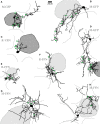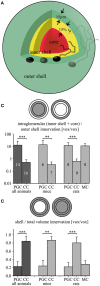Dendritic Arborization Patterns of Small Juxtaglomerular Cell Subtypes within the Rodent Olfactory Bulb
- PMID: 28163674
- PMCID: PMC5247448
- DOI: 10.3389/fnana.2016.00127
Dendritic Arborization Patterns of Small Juxtaglomerular Cell Subtypes within the Rodent Olfactory Bulb
Abstract
Within the glomerular layer of the rodent olfactory bulb, numerous subtypes of local interneurons contribute to early processing of incoming sensory information. Here we have investigated dopaminergic and other small local juxtaglomerular cells in rats and mice and characterized their dendritic arborization pattern with respect to individual glomeruli by fluorescent labeling via patching and reconstruction of dendrites and glomerular contours from two-photon imaging data. Dopaminergic neurons were identified in a transgenic mouse line where the expression of dopamine transporter (DAT) was labeled with GFP. Among the DAT+ cells we found a small short-axon cell (SAC) subtype featuring hitherto undescribed dendritic specializations. These densely ramifying structures clasped mostly around somata of other juxtaglomerular neurons, which were also small, non-dopaminergic and to a large extent non-GABAergic. Clasping SACs were observed also in wild-type mice and juvenile rats. In DAT+ SAC dendrites, single backpropagating action potentials evoked robust calcium entry throughout both clasping and non-clasping compartments. Besides clasping SACs, most other small neurons either corresponded to the classical periglomerular cell type (PGCs), which was never DAT+, or were undersized cells with a small dendritic tree and low excitability. Aside from the presence of clasps in SAC dendrites, many descriptors of dendritic morphology such as the number of dendrites and the extent of branching were not significantly different between clasping SACs and PGCs. However, a detailed morphometric analysis in relation to glomerular contours revealed that the dendrites of clasping SACs arborized mostly in the juxtaglomerular space and never entered more than one glomerulus (if at all), whereas most PGC dendrites were restricted to their parent glomerulus, similar to the apical tufts of mitral cells. These complementary arborization patterns might underlie a highly complementary functional connectivity. The morphometric approach may serve to differentiate also other subtypes of juxtaglomerular neurons, help to identify putative synaptic partners and thus to establish a more refined picture of glomerular network interactions during odor sensing.
Keywords: calcium imaging; dendrites; dendritic arborization analysis; dopaminergic neurons; juxtaglomerular cells; morphological reconstruction; subcellular compartments; two-photon imaging.
Figures






Similar articles
-
Secretagogin-containing neurons in the mouse main olfactory bulb.Neurosci Res. 2013 Sep-Oct;77(1-2):16-32. doi: 10.1016/j.neures.2013.08.006. Epub 2013 Sep 2. Neurosci Res. 2013. PMID: 24008127
-
Serotonin increases synaptic activity in olfactory bulb glomeruli.J Neurophysiol. 2016 Mar;115(3):1208-19. doi: 10.1152/jn.00847.2015. Epub 2015 Dec 9. J Neurophysiol. 2016. PMID: 26655822 Free PMC article.
-
Reciprocal Inhibitory Glomerular Circuits Contribute to Excitation-Inhibition Balance in the Mouse Olfactory Bulb.eNeuro. 2019 Jun 12;6(3):ENEURO.0048-19.2019. doi: 10.1523/ENEURO.0048-19.2019. Print 2019 May/Jun. eNeuro. 2019. PMID: 31147391 Free PMC article.
-
synaptic organization of the glomerulus in the main olfactory bulb: compartments of the glomerulus and heterogeneity of the periglomerular cells.Anat Sci Int. 2005 Jun;80(2):80-90. doi: 10.1111/j.1447-073x.2005.00092.x. Anat Sci Int. 2005. PMID: 15960313 Review.
-
Neuronal organization of the main olfactory bulb revisited.Anat Sci Int. 2016 Mar;91(2):115-27. doi: 10.1007/s12565-015-0309-7. Epub 2015 Oct 29. Anat Sci Int. 2016. PMID: 26514846 Review.
Cited by
-
Brief sensory deprivation triggers plasticity of dopamine-synthesising enzyme expression in genetically labelled olfactory bulb dopaminergic neurons.Eur J Neurosci. 2022 Jul;56(1):3591-3612. doi: 10.1111/ejn.15684. Epub 2022 May 19. Eur J Neurosci. 2022. PMID: 35510299 Free PMC article.
-
Structural Features of an OR37 Glomerulus: A Comparative Study.Front Neuroanat. 2017 Dec 18;11:125. doi: 10.3389/fnana.2017.00125. eCollection 2017. Front Neuroanat. 2017. PMID: 29326560 Free PMC article.
-
Loss of odor-induced c-Fos expression of juxtaglomerular activity following maintenance of mice on fatty diets.J Bioenerg Biomembr. 2019 Feb;51(1):3-13. doi: 10.1007/s10863-018-9769-5. Epub 2018 Sep 11. J Bioenerg Biomembr. 2019. PMID: 30203289 Free PMC article.
-
Short-term plasticity in glomerular inhibitory circuits shapes olfactory bulb output.J Neurophysiol. 2020 Mar 1;123(3):1120-1132. doi: 10.1152/jn.00628.2019. Epub 2020 Jan 29. J Neurophysiol. 2020. PMID: 31995427 Free PMC article.
-
Vasopressin Cells in the Rodent Olfactory Bulb Resemble Non-Bursting Superficial Tufted Cells and Are Primarily Inhibited upon Olfactory Nerve Stimulation.eNeuro. 2019 Jul 10;6(4):ENEURO.0431-18.2019. doi: 10.1523/ENEURO.0431-18.2019. Print 2019 Jul/Aug. eNeuro. 2019. PMID: 31217196 Free PMC article.
References
LinkOut - more resources
Full Text Sources
Other Literature Sources
Miscellaneous

